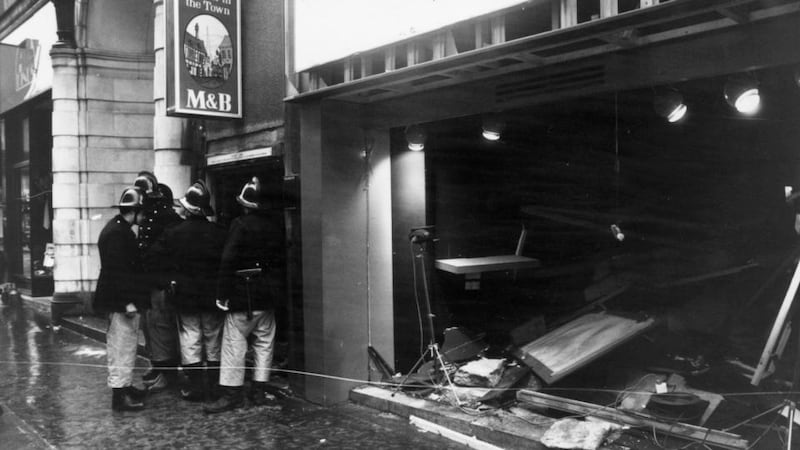New Street in Birmingham is a place of old wounds. One of the worst obscenities of the Troubles was perpetrated here exactly 50 years ago next month. It echoes still for the victims’ families and also for the local Irish community, who for years afterwards paid a price for the murderous actions of others.
New Street is a pedestrian thoroughfare that bisects the commercial heart of Birmingham. It runs downhill from the Town Hall at Victoria Square towards the Bullring, Birmingham’s retail mecca. Three-quarters of the way down, on the right hand side, lies King Edward House, a once-sumptuous art deco building that, this week, appeared to be in the middle of a revamp. To the right of the main entrance was once a black door, now blocked up, that led to a basement bar, the Tavern in the Town.
About 200 metres further on, the 25-storey Rotunda round tower looms over the Bullring. The ground floor includes a Zara fashion outlet and EL&N, a fancy cakes and coffee shop. But half a century ago the Rotunda housed a pub, the Mulberry Bush, at street level and in the basement.
On a Thursday evening, November 21st, 1974, the first bomb went off near the back door of the packed Mulberry Bush at 8.17pm, collapsing part of the roof. People who arrived to help described a scene of pure hell.
READ MORE

Exactly 10 minutes later, as police were clearing the Tavern in the Town, the second bomb exploded there near the bottom of the stairs leading down to the bar. The force of the blast obliterated those nearby. Just ordinary people out in the city centre for a drink before the weekend. Now gone.
In all, 21 people died in the Birmingham pub bombings and close to 200 were injured, many of them severely, with life-changing traumas. The IRA never admitted responsibility, even when six innocent local Irishmen were arrested within hours and wrongly convicted of the murders. The Birmingham Six were not exonerated until 1991, after spending 16 years in jail.
[ The story of the Irish in Britain comes ‘home home’Opens in new window ]
Maurice Malone, whose parents were born in Ireland, was aged seven at the time. He remembers the events. As well as destroying the lives of victims and their families, the bombs also “blew away the Irish community”, he told me this week.
There was a fierce backlash against Irish families. Malone, now the chief executive of the Birmingham Irish Association (BIA), recalled the impact of the bomb on his family in the 50 Years of the Irish in Britain oral history project, which toured Ireland and the UK and can be found online.
Along with many other Irish people, Malone’s father lost his job in Birmingham shortly after the bombings. He was beaten up by former colleagues. He told his son the marks on his face came from a fall. He never returned to work, and spiralled into alcoholism that devastated the family.
“Everyone in the Irish community retreated into themselves after the bombings,” Malone told me. “My mother wouldn’t even go on a bus in Birmingham because of her thick Dublin accent.”
The loved ones of the 21 victims are still fighting to learn the truth. Meanwhile, Malone said, it took decades for the Irish community to begin the healing process. Birmingham became a place where Irishness wasn’t as openly celebrated as it was in other British cities.
Eventually that began to change. Through Malone and the BIA, the Irish community grew links with victims’ families. For years the only memorial was a small, perfunctory stone pillar that still stands on the green outside Birmingham Cathedral. Six years ago, Malone heard Network Rail had funding for public art projects. The BIA received funding to commission an artist, Anu Patel, to construct three large metal trees, each with seven leaves – 21 in all, one for each for the victims.
The tree sculpture sits outside New Street station. On Tuesday, I took a break from the Tory conference and sat beneath the art work. When you look up, you notice the names of the victims are chiselled through the leaves, illuminating them against the backdrop of the light of the sky above. The Irish Government gave funding to pay for lights that, at night, project the names on to the pavement below. Maxine Hambleton, John Rowlands, Lynn Bennett and all the other victims.
Next month, Birmingham’s Irish community with join victims’ families, faith leaders and, they hope, important political guests to commemorate the 50th anniversary of the bombings. They will gather at the tree sculpture on the afternoon of November 21st. Malone has invited emergency services, schools, universities and anybody else in the city, or anywhere, who wants to join in to observe a minute’s silence to remember what happened – and what never should have been.















